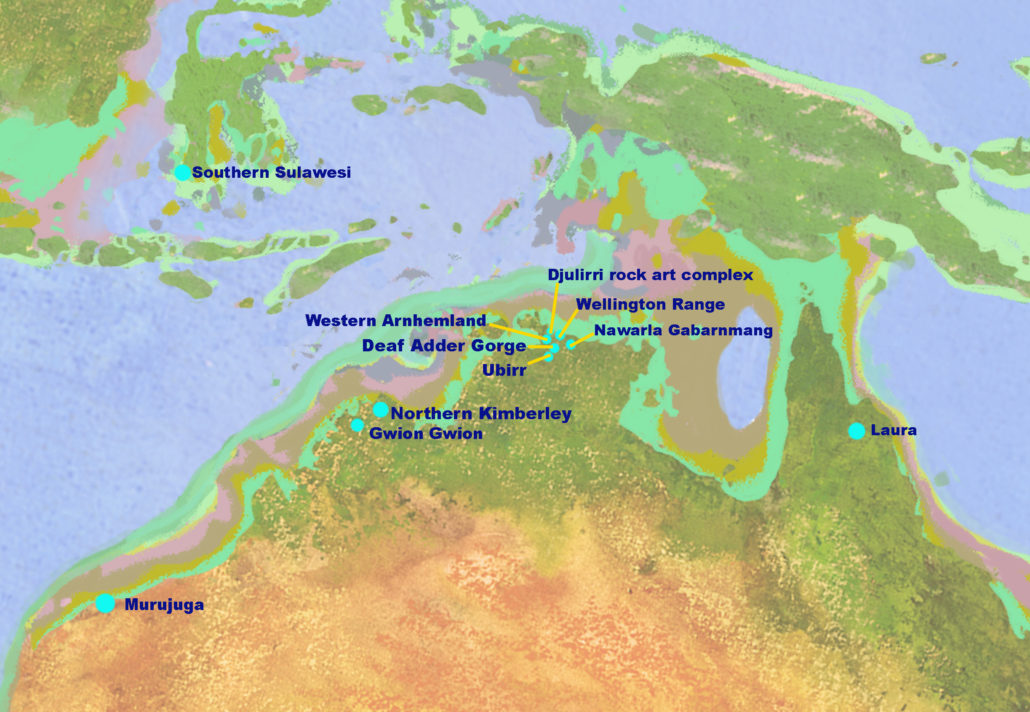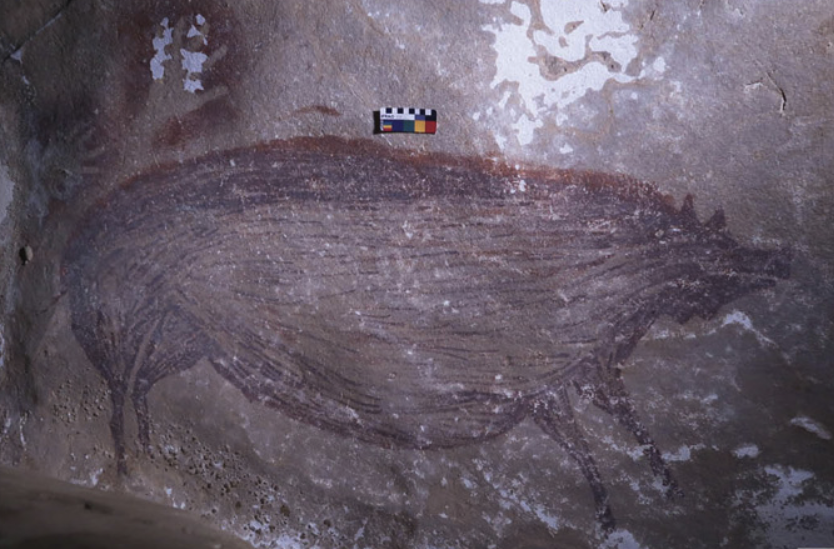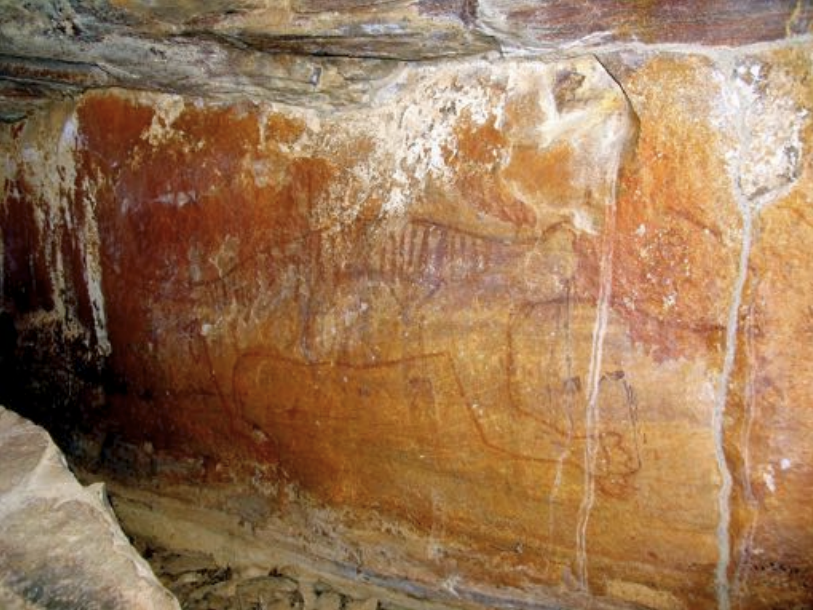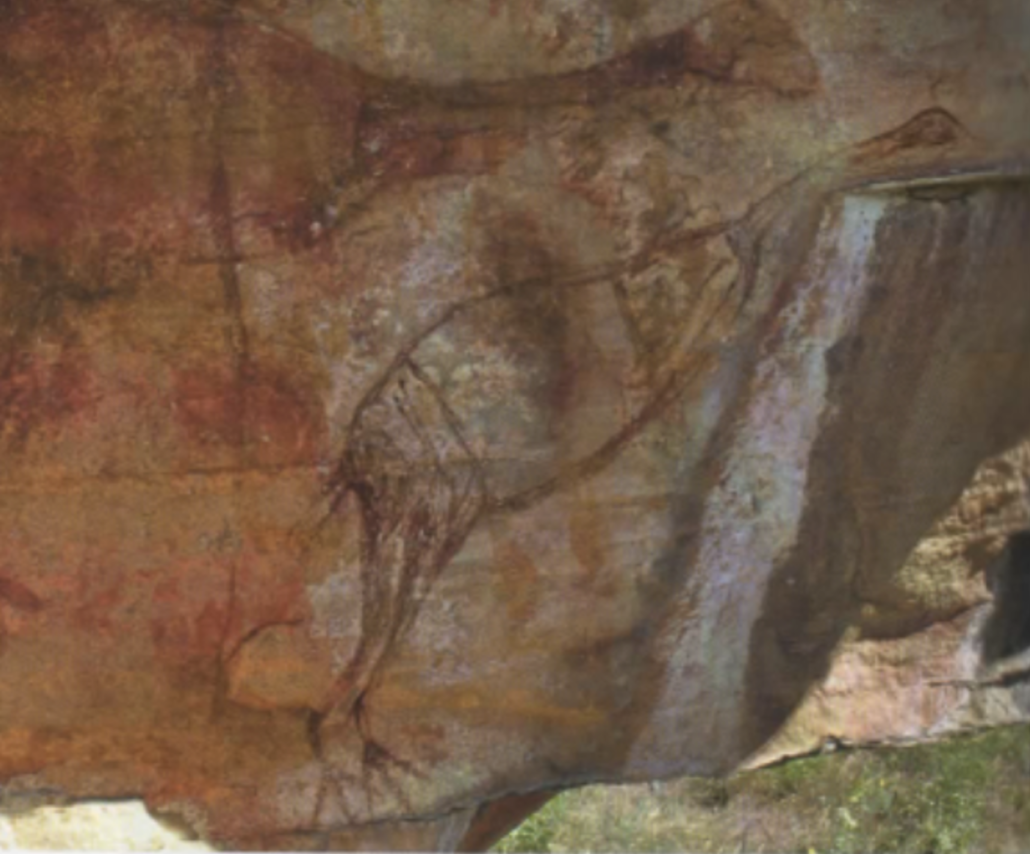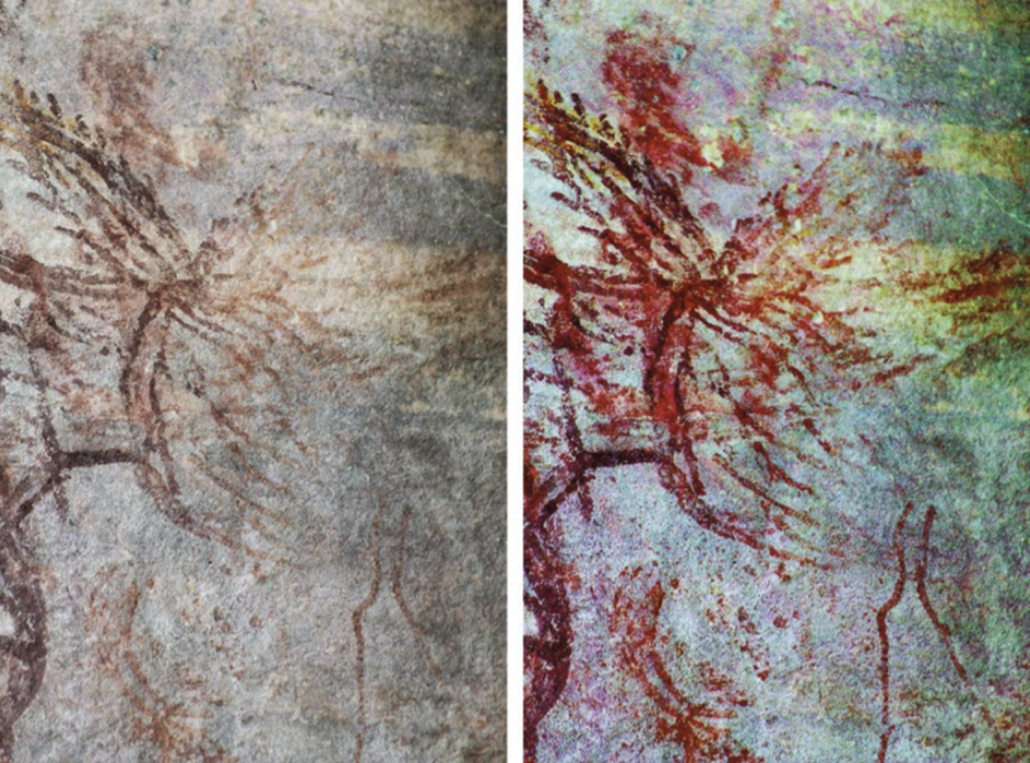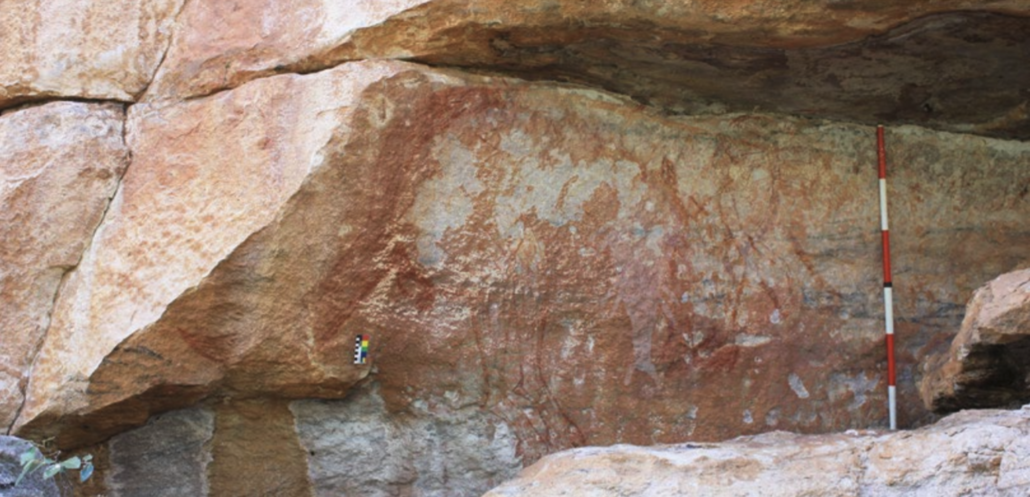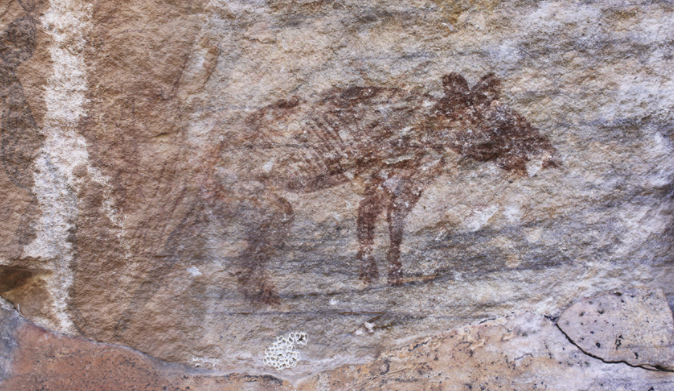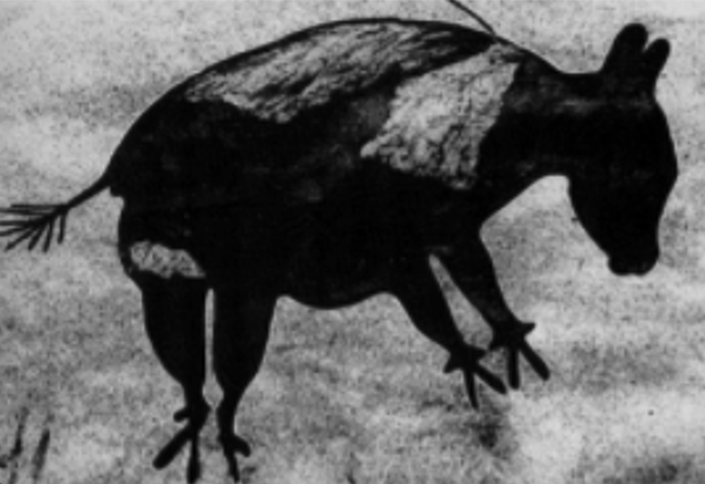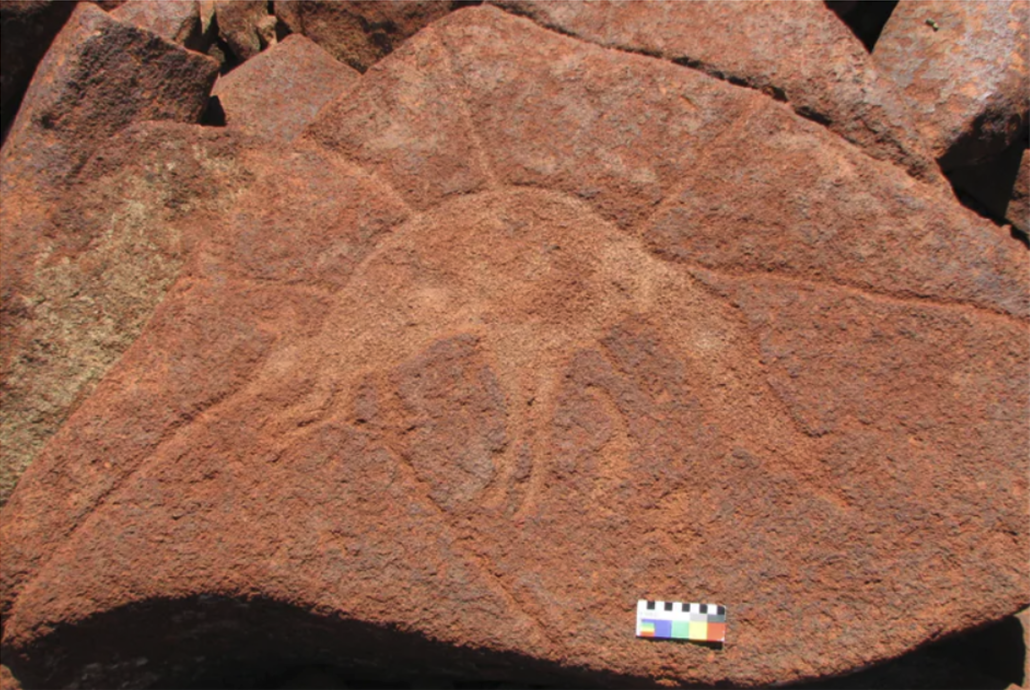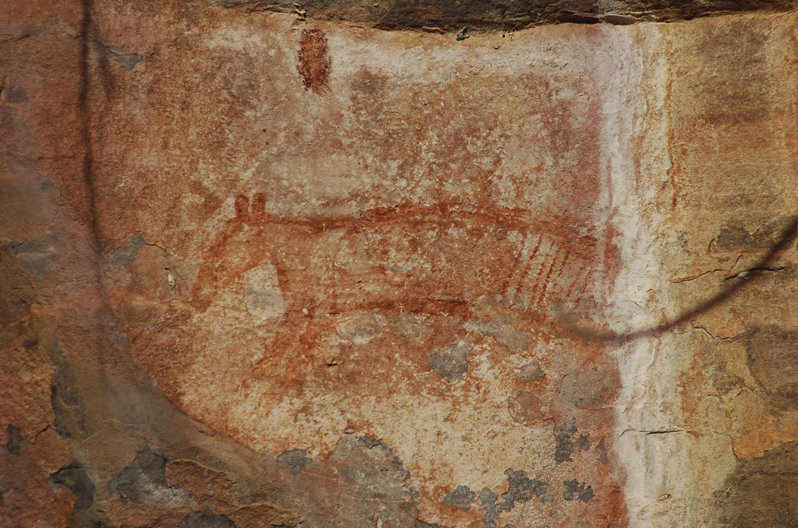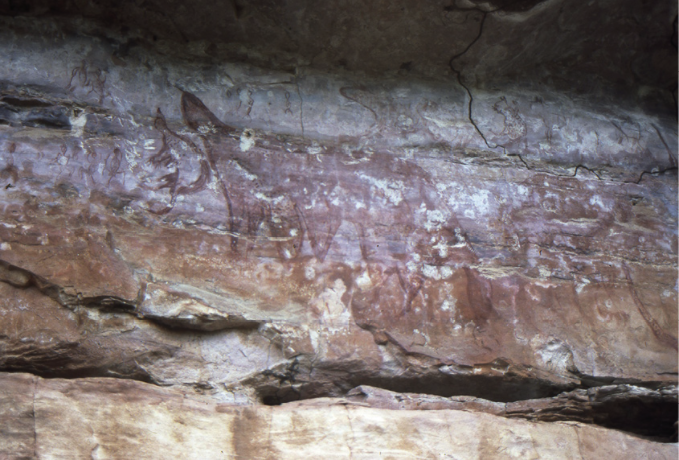Megafauna and Rock Art
Language Points
Guugu Yimithirr
A long time ago, animals that don’t exist anymore lived in this country. Scientists have found their bones in the ground and have studied them. Because many of these ancient animals were bigger than the animals of today, scientists have called them ‘megafauna’ (in Latin ‘mega’ means ‘big’ and ‘fauna’ means ‘animals’). Most of these animals disappeared long before people arrived in Sahul. But some of these giant animals were still here when people arrived in the Country and they lived side by side with people for a long time before dying out.
Scientists disagree about why these animals disappeared: many scientists think the changing climate was the reason the animals died out, but some scientists think people’s burning and hunting could have also made it difficult for the last of the megafauna to survive.
Scientists also disagree about when these animals disappeared: some think this happened around 50,000-40,000 years ago, while others think some of these animals continued to live in the country until 30,000-20,000 years ago. But it is likely that when the first people came to Sahul they would have met a marsupial lion that jumped on its prey from trees and a crocodile-like creature that scientists have called ‘Ziphodont’ or ‘Quinkana’ , which unlike today’s saltwater crocodiles, lived on land and had long legs that made him a fast hunter. The first people in Australia likely also crossed paths with the ‘Megalania/Varanus prisca’, a giant goanna, the largest lizard that ever lived on earth as well as a giant constrictor snake, the ‘Wonambi’.
Australia has more rock art sites than any other country in the world. Rock art is everywhere in the country. The northern regions are especially rich in rock art sites. There are both rock paintings and rock carvings. Some are very old, others are recent. People have been painting and carving pictures on rocks for a long time.
Scientists also disagree about the age of the oldest rock art in Australia, but we know that rock paintings can survive for a very long time. In fact, in 2017 scientists dated the rock painting of a pig found in Sulawesi, Indonesia, just north of Australia, to be at least 45,500 years old. This painting is in a rock shelter like the ones in Arnhem Land. This means that our paintings could be just as old as the painting in Sulawesi.
English
A long time ago, animals that don’t exist anymore lived in this country. Scientists have found their bones in the ground and have studied them. Because many of these ancient animals were bigger than the animals of today, scientists have called them ‘megafauna’ (in Latin ‘mega’ means ‘big’ and ‘fauna’ means ‘animals’). Most of these animals disappeared long before people arrived in Sahul. But some of these giant animals were still here when people arrived in the Country and they lived side by side with people for a long time before dying out.
Scientists disagree about why these animals disappeared: many scientists think the changing climate was the reason the animals died out, but some scientists think people’s burning and hunting could have also made it difficult for the last of the megafauna to survive.
Scientists also disagree about when these animals disappeared: some think this happened around 50,000-40,000 years ago, while others think some of these animals continued to live in the country until 30,000-20,000 years ago. But it is likely that when the first people came to Sahul they would have met a marsupial lion that jumped on its prey from trees and a crocodile-like creature that scientists have called ‘Ziphodont’ or ‘Quinkana’ , which unlike today’s saltwater crocodiles, lived on land and had long legs that made him a fast hunter. The first people in Australia likely also crossed paths with the ‘Megalania/Varanus prisca’, a giant goanna, the largest lizard that ever lived on earth as well as a giant constrictor snake, the ‘Wonambi’.
Australia has more rock art sites than any other country in the world. Rock art is everywhere in the country. The northern regions are especially rich in rock art sites. There are both rock paintings and rock carvings. Some are very old, others are recent. People have been painting and carving pictures on rocks for a long time.
Scientists also disagree about the age of the oldest rock art in Australia, but we know that rock paintings can survive for a very long time. In fact, in 2017 scientists dated the rock painting of a pig found in Sulawesi, Indonesia, just north of Australia, to be at least 45,500 years old. This painting is in a rock shelter like the ones in Arnhem Land. This means that our paintings could be just as old as the painting in Sulawesi.
Map
Guugu Yimithirr
In Australian rock art there are images of many things: animals, people, patterns, tracks, tools, plants, ancestral beings, as well as ships, guns, cattle and many other things.
Hover and click on hotspot Number 1 on the map to see a rock painting of a pig found in Sulawesi, Indonesia, just north of Australia that has been dated to at least 45,500 years old.
Traditional owners and scientists think that some of the pictures of animals do not look like any of the animals alive today. Some people think these may be paintings of Ancestral Beings or story creatures. Others think these may be pictures of megafauna that were painted a long time ago, before these animals became extinct. Some of the animals have been painted with details that match what scientists think megafauna might have looked like.
For more information see: Paul S.C. Taçon and Steve Webb https://press-files.anu.edu.au/downloads/press/n3991/html/ch08.xhtml?referer=&page=13
Hover and click on hotspots number 2 to number 8 and 11 on the map to discover rock art that might be representing extinct megafauna.
Hover and click on hotspot 9 and 10 on the map to see art representing species that are now extinct in that area.
English
In Australian rock art there are images of many things: animals, people, patterns, tracks, tools, plants, ancestral beings, as well as ships, guns, cattle and many other things.
Hover and click on hotspot Number 1 on the map to see a rock painting of a pig found in Sulawesi, Indonesia, just north of Australia that has been dated to at least 45,500 years old.
Traditional owners and scientists think that some of the pictures of animals do not look like any of the animals alive today. Some people think these may be paintings of Ancestral Beings or story creatures. Others think these may be pictures of megafauna that were painted a long time ago, before these animals became extinct. Some of the animals have been painted with details that match what scientists think megafauna might have looked like.
For more information see: Paul S.C. Taçon and Steve Webb https://press-files.anu.edu.au/downloads/press/n3991/html/ch08.xhtml?referer=&page=13
Hover and click on hotspots number 2 to number 8 and 11 on the map to discover rock art that might be representing extinct megafauna.
Hover and click on hotspot 9 and 10 on the map to see art representing species that are now extinct in that area.
Rock Art as a history book
Language Points
Guugu Yimithirr
Rock art has always been used by bama, among many other things, to help remembering and passing down information to younger generations together with stories, songs, dance.
Information and knowledge can be passed down for a very long time this way.
For example, the Pitjantjatjara of the Central Desert, when performing the ‘dog dreaming’ every year during initiation ceremonies aren’t referring to dingo, but to the marsupial dog or Tasmanian tiger, which disappeared from mainland Australia at least 4,000/3,000 years ago.
There are pictures of Tasmanian tigers in many rock art paintings across the country and in petroglyphs in Murujuga. These remind us and show us that this animal used to live in mainland Australia a long time ago. It survived in Tasmania until recently, when Europeans hunted it to extinction.
Rock art can also help us understand how the climate and vegetation has changed.
For example, in Western Arnhem Land, there are pictures of bilbies/bandicoots. These animals used to live here at a time when the weather was much drier. They disappeared from Arnhem Land a few thousand years ago but continue to live in other dry parts of the Country.
English
Rock art has always been used by bama, among many other things, to help remembering and passing down information to younger generations together with stories, songs, dance.
Information and knowledge can be passed down for a very long time this way.
For example, the Pitjantjatjara of the Central Desert, when performing the ‘dog dreaming’ every year during initiation ceremonies aren’t referring to dingo, but to the marsupial dog or Tasmanian tiger, which disappeared from mainland Australia at least 4,000/3,000 years ago.
There are pictures of Tasmanian tigers in many rock art paintings across the country and in petroglyphs in Murujuga. These remind us and show us that this animal used to live in mainland Australia a long time ago. It survived in Tasmania until recently, when Europeans hunted it to extinction.
Rock art can also help us understand how the climate and vegetation has changed.
For example, in Western Arnhem Land, there are pictures of bilbies/bandicoots. These animals used to live here at a time when the weather was much drier. They disappeared from Arnhem Land a few thousand years ago but continue to live in other dry parts of the Country.

